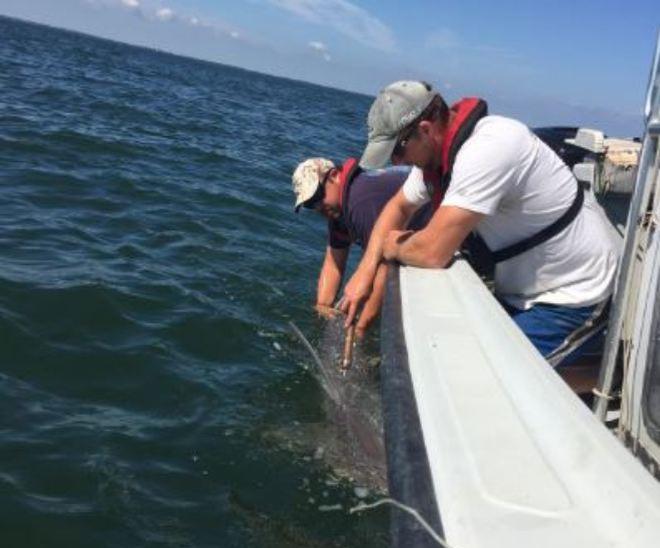Estuarine Waters Home to shark nursery habitat along East Coast
by NOAA Fisheries on 6 Oct 2017

NEFSC staff prepare to tag a large female sandbar shark caught during the Cooperative Atlantic States Shark Pupping and Nursery (COASTSPAN) survey in Delaware Bay in July. Mature female sandbar sharks come into this estuary to give birth during the summer months. Apex Predators Program / NOAA Fisheries
Each summer, scientists from the Northeast Fisheries Science Center (NEFSC) and colleagues in states along the East Coast conduct surveys in estuaries and nearshore waters to monitor and study known and suspected shark nursery habitat.
The work is part of the Cooperative Atlantic States Shark Pupping and Nursery (COASTSPAN) program, an ongoing effort to understand what species live in these locations and why.
Surveys are conducted from northern Florida to Rhode Island’s Narragansett Bay to determine the relative abundance, distribution and migrations of various shark species using these nurseries through longline and gillnet sampling and mark-recapture data.
“In the Northeast, COASTSPAN surveys primarily catch juvenile sandbar sharks and in Delaware Bay, occasionally mature female sandbar sharks are caught as well as smooth dogfish and sand tigers of all life stages,” said Cami McCandless, a shark researcher with the NEFSC’s Apex Predators Program at the Narraganset Laboratory in Rhode Island who heads the COASTSPAN program. “We also catch several more southern species but in much fewer numbers.”
COASTSPAN in the southeast catches a larger variety of sharks due to the warmer temperatures. “Sandbar sharks are caught in the southeast as well, but in much lower numbers. During the summer months when we conduct the survey, the majority of them have migrated north to cooler waters,” McCandless said. “Small coastal sharks like the bonnethead and Atlantic sharpnose are abundant in all life stages in estuarine waters in this region.”
Other species commonly caught as juveniles in the southeast surveys are blacktip, finetooth, scalloped hammerhead, spinner, and tiger sharks.
NEFSC staff conduct the survey in Delaware Bay in late June, mid-July, and early August. Two surveys are actually done, the first is a longline survey using small hooks to target juvenile sandbar sharks that use the bay as nursery habitat. The smaller gear is a random stratified survey by depth and geographic location throughout the bay. The second longline survey uses larger hooks to target sand tiger sharks at fixed locations near structures such as wrecks or where channels meet shoal areas that attract sand tigers.
COASTSPAN surveys in Virginia are conducted by staff from the Virginia Institute of Marine Science, and in South Carolina by staff from the South Carolina Department of Natural Resources (SCDNR). University of North Florida staff conduct COASTSPAN surveys in the estuarine and nearshore waters of Georgia and northern Florida, and staff from the Massachusetts Division of Marine Fisheries conducts survey work in the U.S. Virgin Islands.
Florida Atlantic University staff recently finished a pilot COASTSPAN survey off the eastern coast of Florida near Ft. Pierce. Additionally, the SCDNR, Georgia Department of Natural Resources, North Carolina Division of Marine Fisheries, Florida Fish and Wildlife Commission, and NASA Kennedy Space Center use COASTSPAN tags during their state and federal surveys in estuarine and nearshore waters. Volunteers from NOAA Fisheries Highly Migratory Species Management Division and from other public, academic and state institutions also help with the summer COASTSPAN surveys.
While tags are supplied to all the participating organizations, the number of smooth dogfish tagged in the Northeast and Atlantic sharpnose in the southeast are limited due to the high catches and limited tag supply. Nearly 3,000 tags are distributed during the annual survey, which began in 1998. Narragansett Bay, Rhode Island was not surveyed this year due to logistical constraints.
“We tag and release the majority of sharks captured to study their movements and migrations to better understand their seasonal distributions and to help define essential fish habitat for managed shark species,” McCandless said. “The shark catch per unit effort data from the surveys are standardized to account for environmental effects, and incorporated into stock assessment models for managed species.”
During the first few years of the COASTSPAN project, the NEFSC, in cooperation with Albion College, conducted exploratory surveys to determine the use of the Dry Tortugas as mating and nursery habitat by the nurse shark. This work resulted in designation of the first NMFS Habitat Area of Particular Concern (HAPC) and seasonal closures of the area by the National Park Service.
COASTSPAN work also led to the designation of Delaware Bay as a HAPC for juvenile sandbar sharks and all life stages of sand tigers, and the identification of critical shark nursery habitat for blacktip and lemon sharks in Fish Bay, USVI. HAPCs are considered high priority areas for conservation, management, or research because they are rare, sensitive, stressed by development, or important to ecosystem function and healthy fish populations.
While the survey does not currently sample the nearshore waters off Long Island, the continental shelf waters of the Mid-Atlantic Bight were first reported as potential nursery habitat for white sharks by NEFSC biologists John Casey and Harold “Wes” Pratt in 1985. McCandless and other NEFSC scientists were co-authors of a 2014 study of the seasonal distribution and trends of white sharks that found “waters less than 50 meters (about 165 feet) deep on the broad continental shelf in the New York Bight area may represent primary nursery habitat for white sharks.”
If you want to link to this article then please use this URL: www.sailworldcruising.com/157806